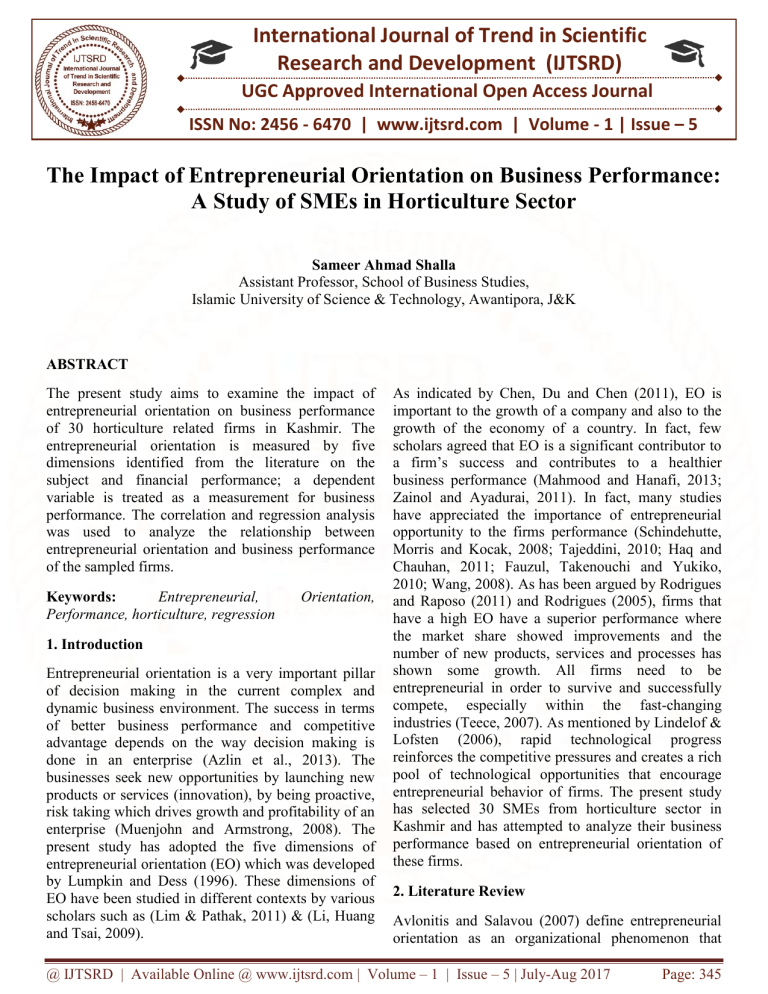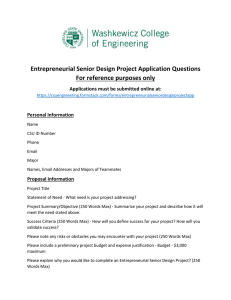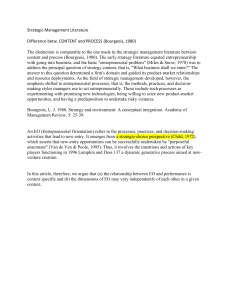
International Journal of Trend in Scientific
Research and Development (IJTSRD)
UGC Approved International Open Access Journal
ISSN No: 2456 - 6470 | www.ijtsrd.com | Volume - 1 | Issue – 5
The Impact of Entrepreneurial Orientation on Business Performance:
A Study of SMEs in Horticulture Sector
Sameer Ahmad Shalla
Assistant Professor, School of Business Studies,
Islamic University of Science & Technology, Awantipora, J&K
ABSTRACT
The present study aims to examine the impact of
entrepreneurial orientation on business performance
of 30 horticulture related firms in Kashmir. The
entrepreneurial orientation is measured by five
dimensions identified from the literature on the
subject and financial performance; a dependent
variable is treated as a measurement for business
performance. The correlation and regression analysis
was used to analyze the relationship between
entrepreneurial orientation and business performance
of the sampled firms.
Keywords:
Entrepreneurial,
Performance, horticulture, regression
Orientation,
1. Introduction
Entrepreneurial orientation is a very important pillar
of decision making in the current complex and
dynamic business environment. The success in terms
of better business performance and competitive
advantage depends on the way decision making is
done in an enterprise (Azlin et al., 2013). The
businesses seek new opportunities by launching new
products or services (innovation), by being proactive,
risk taking which drives growth and profitability of an
enterprise (Muenjohn and Armstrong, 2008). The
present study has adopted the five dimensions of
entrepreneurial orientation (EO) which was developed
by Lumpkin and Dess (1996). These dimensions of
EO have been studied in different contexts by various
scholars such as (Lim & Pathak, 2011) & (Li, Huang
and Tsai, 2009).
As indicated by Chen, Du and Chen (2011), EO is
important to the growth of a company and also to the
growth of the economy of a country. In fact, few
scholars agreed that EO is a significant contributor to
a firm’s success and contributes to a healthier
business performance (Mahmood and Hanafi, 2013;
Zainol and Ayadurai, 2011). In fact, many studies
have appreciated the importance of entrepreneurial
opportunity to the firms performance (Schindehutte,
Morris and Kocak, 2008; Tajeddini, 2010; Haq and
Chauhan, 2011; Fauzul, Takenouchi and Yukiko,
2010; Wang, 2008). As has been argued by Rodrigues
and Raposo (2011) and Rodrigues (2005), firms that
have a high EO have a superior performance where
the market share showed improvements and the
number of new products, services and processes has
shown some growth. All firms need to be
entrepreneurial in order to survive and successfully
compete, especially within the fast-changing
industries (Teece, 2007). As mentioned by Lindelof &
Lofsten (2006), rapid technological progress
reinforces the competitive pressures and creates a rich
pool of technological opportunities that encourage
entrepreneurial behavior of firms. The present study
has selected 30 SMEs from horticulture sector in
Kashmir and has attempted to analyze their business
performance based on entrepreneurial orientation of
these firms.
2. Literature Review
Avlonitis and Salavou (2007) define entrepreneurial
orientation as an organizational phenomenon that
@ IJTSRD | Available Online @ www.ijtsrd.com | Volume – 1 | Issue – 5 | July-Aug 2017
Page: 345
International Journal of Trend in Scientific Research and Development (IJTSRD) ISSN: 2456-6470
reflects a managerial capability by which firms
embark on proactive and aggressive initiatives to alter
the competitive situation to their advantage. Lumpkin
and Dess (1996) developed five dimensions that
characterize the EO of a firm: innovativeness,
proactiveness, risk taking, competitive aggressiveness
and autonomy. Innovativeness reflects the tendency to
engage in and support new ideas, novelty,
experimentation and creative processes resulting in
something new. Pro-activeness reflects a firm’s
actions in exploiting and anticipating emerging
opportunities by developing and introducing as well
as making improvements towards a product or a
service (Lumpkin and Dess, 1996). Risk-taking
represents the willingness to commit resources to
undergo activities and projects which resulted in
uncertainty of the outcomes (Lumpkin and Dess,
1996). Risk-taking is defined as the extent to which a
firm is willing to make large and risky commitments
(Covin and Slevin, 1991). Competitive aggressiveness
is the intensity of the firm’s to improve their position
to outdo and overtake their competitors in the market
(Lumpkin and Dess, 1996). It is characterized by a
strong offensive posture directed at overcoming
competitors and may be quite reactive as when a firm
aggressively enters a market that a rival has identified
(Lumpkin and Dess, 1997). Autonomy refers to an
independent action of an individual or teams in
ensuring ideas and concepts are being carried out till
completion (Lumpkin and Dess, 1996). Autonomy
gives employees the chance to perform effectively by
being independent, self-directed, creative and
teleological. As suggested by Knight (2000), majority
of earlier studies have adopted self-reported measures
to gather business performance data which have
proven to be reliable. Moreover, Yang (2008) asserts
that public information provided by small and
medium enterprises is unreliable as most of the firms
are privately held and they have no legal obligation to
disclose information. According to Wiklund (1999),
financial performance is a common performance
measurement. The researcher has therefore relied on
financial performance as a measurement of business
performance. The relationship between EO and firm
performance has become the main subject of interest
in past literatures. According to Rauch, Wiklund,
Lumpkin and Frese (2009), it is likely for firms
adopting EO to perform better than companies that
adopt conservative orientation. Initially, one could
question the importance of EO for the success of
enterprises. Thus, previous research studies have
shown
that entrepreneurial opportunity could
significantly improve business performance (Covin
and Slevin, 1991; Lumpkin and Dess, 1996; Wiklund
and Shepherd, 2005; Covin and Slevin 1989;
Lumpkin and Dess, 2001). There are various studies
on EO and business performance that have reported
positive results (Jantunen, Puumalainen, Saarenketo,
and Kylaheiko, 2005; Chow, 2006; Coulthard, 2007;
Wiklund, 1999; Wiklund and Shepherd, 2003, 2005;
Zahra, 1991; Zahra and Covin, 1995; Madsen, 2007;
Keh, Nguyen and Ng, 2007; Lee, Lee and Penning,
2001; Lumpkin and Dess, 1996). However, there is no
doubt there are also studies that revealed that EO does
not give positive results to business performance
(Hart, 1992; Matsuno, Mentzer and Ozsomer, 2002;
Morgan and Strong, 2003; Smart and Conant 1994).
3. Objectives:
a) To
study
the
relationship
between
entrepreneurial orientation and financial
performance of 30 horticulture related
business firms in Kashmir.
4. Hypotheses
H01: Autonomy is not associated with profitability.
H02: Pro-activeness is not related with profitability.
H03: Innovativeness is not related with profitability.
H04: Risk taking is not related with profitability.
H05: Competitive aggressiveness is not associated
with business performance.
5. Methodology
The present study has adopted a descriptive cum
exploratory methodology for achieving the objective
of the current study. The data was collected using a
questionnaire based on a 5-point Likert Scale. The
questionnaire was distributed among top 50 firms in
Sopore fruit Mandi in Baramulla district. However,
only 30 firms responded to the survey questionnaire
resulting in 60% response rate. According to Roscoe’s
(1975) rule of thumb, a sample size between 30 and
500 is sufficient. Since, small and medium firms are
run by few individuals with centralized authority,
therefore, they are the most informed individuals
about the firms’ overall operational activities (Yang,
2008). The entrepreneurial orientation (OE): an
independent variable (IV) was measured by 5
identified dimensions from the literature and
profitability was used a measurement for business
performance which is a dependent variable (DV). The
data was analyzed using both descriptive and
@ IJTSRD | Available Online @ www.ijtsrd.com | Volume – 1 | Issue – 5 | July-Aug 2017
Page: 346
International Journal of Trend in Scientific Research and Development (IJTSRD) ISSN: 2456-6470
inferential statistical tools for drawing accurate
inference and interpretation. The SPSS 20.0 was used
for data analysis.
business performance have a Cronbach Alpha values
of more than 0.68 which is acceptable according to
Hair and Page (2008). The results are reported in table
1.2.
6. Results & Analysis
Table 1.2 Results of Reliability Test
The sample consists of 30 horticulture related
businesses. All the respondents are from small &
medium size enterprises. Since, Sopore is known as
Apple town with heavy concentration of fruit growers
and one of the biggest fruit markets in India.
Therefore, all the firms have been selected from the
Sopore fruit mandi.
Table 1.1: Sample Profile
Sector
Horticulture
Company Size
Small
Location
Sopore, Kashmir
N
30
Source: Field Survey
Measure
Innovativeness
Pro-activeness
Autonomy
Risk-taking
Competitive
aggressiveness
Business
Performance
6
5
6
8
Cronbach
Aplha
.73
.71
.72
.70
7
.68
8
.71
Items
Table 1.3 depicts the correlation analysis between the
five dimensions of EO and business performance. It
was observed that the Pearson correlation between EO
& Innovativeness is significant at .567; EO & Proactiveness is significant at .452, EO & Autonomy at
.432, OE & Risk-taking at .390, OE and Competitive
aggressiveness at .379.
The reliability test was conducted for ascertaining the
internal consistency of the dependent and independent
variables. The entrepreneurial orientation and
Table 1.3: Correlation between OE (5 dimensions) & Business Performance
OE
Business Performance (BP)
Innovativeness
.567**
Pro-activeness
.452**
Autonomy
.432**
Risk-taking
.390**
Competitive aggressiveness
.379**
**Correlation is significant at the 0.01 level (2-tailed).
After correlation analysis multiple regression was conducted to investigate the relationship between OE and
BP. The results of the regression analysis was presented in table 1.4.
@ IJTSRD | Available Online @ www.ijtsrd.com | Volume – 1 | Issue – 5 | July-Aug 2017
Page: 347
International Journal of Trend in Scientific Research and Development (IJTSRD) ISSN: 2456-6470
Table 1.4: Regression Model Summary
Model
R
R Square
Adjusted R
Square
Std. Error of the
Estimate
EO
.621a
.412
.255
5.71
a. Predictors: (constant), IN, RT, PA, AUT, CA
The R square value is .412 which indicates that 41.20% of variance in business performance (BP) is explained
by five dimensions of entrepreneurial orientation (OE).
Table 1.5: Coefficients
Model
Innovativeness
Pro-activeness
Autonomy
Risk-taking
Competitive
aggressiveness
Unstandardized
Coefficients
B
Std. Error
.790
.330
.316
.537
.223
.340
.482
.344
1.21
.247
Standardized
Coefficients
Beta
.270
.268
.140
.132
t
Sig.
2.16
1.23
1.43
1.67
.000
.000
.000
.000
.129
2.1
.000
a. DV: Business Performance of Horticulture related Firms
The coefficients in the above table 1.5 show which
among the five independent variables of EO
influences most the variance in business performance.
The column Beta under Standardized Coefficients
shows that the highest number in the beta is .270 for
innovativeness which is significant at the .001. Proactiveness was ranked second with beta 0.268 at the
significant .001 followed by Autonomy dimension
with beta 0.140 at the significant .001, risk-taking
with beta .132 and Competitive aggressiveness with
beta .129 all dimensions are significant at the level
0.05. All five dimensions of EO significantly affect
the business performance of horticulture related firms.
Hence, Hypothesis 1, 2, 3, 4 and 5 are rejected.
7. Conclusion
It was observed from correlation analysis that there is
a small to medium
association between EO and
business performance. The study also revealed that all
the five dimensions of Lumpkin and Dess’s (1996)
EO significantly effect the business performance of
30 selected horticulture related business firms. The
study is limited to the perceptions of the performance
& EO of only 30 companies in horticulture sector of
J&K. Therefore, in view of the enormous significance
of horticulture sector for the development of economy
of J&K further broad based research studies with
more objective performance measurements should be
adopted. Which could better determine the behavior
of business performance and entrepreneurial
orientation in horticulture sector.
REFERENCES
1) Avlontis, G.J. and Salavou, H.E. (2007),
“Entrepreneurial orientation of SMEs, product
innovativeness, and performance”, Journal of
Business Research, Vol. 60 (5), 566-75.
Biotechnology Information Centre, Malaysia.
(2001). Retrieved 23 October 2012, from
http://www.bic.org.my/index.html.
2) Chen, G., Du, H., and Chen, Y. (2011). Research
on
Entrepreneurial
Orientation
and
Entrepreneurial Behavior: An Empirical Study. In
Management and Service Science (MASS), 2011
International Conference on (pp. 1-3). IEEE.
@ IJTSRD | Available Online @ www.ijtsrd.com | Volume – 1 | Issue – 5 | July-Aug 2017
Page: 348
International Journal of Trend in Scientific Research and Development (IJTSRD) ISSN: 2456-6470
3) Chow, I.H. (2006). The Relationship between
Entrepreneurial Orientation and Firm Performance
in China. S A.M. Advanced Management Journal,
71 (3), 11–20.
4) Coulthard, M. (2007). The Role of Entrepreneurial
Orientation on Firm Performance and the Potential
Influence of Relational Dynamism. Journal of
Global Business and Technology. 3 (1), 29–39.
5) Covin, J.G. and Slevin, D.P. (1989). Strategic
Management of Small Firms in Hostile and
Benign Environments. Strategic Management
Journal. 10 (1), 75–87.
6) Covin, J.G. and Slevin, D.P. (1991). A Conceptual
Model of Entrepreneurship as Firm Behavior.
Entrepreneurship Theory and Practice. 16, 7- 25.
7) Creswell, J.W. (2005). Educational Research:
Planning,
Conducting,
and
Evaluating
Quantitative and Qualitative Research (2nd ed.).
Upper Saddle River, N.J.: Pearson Education.
8) Fauzul, M. F., Takenouchi, H., and Yukiko, T.
(2010). entrepreneurial orientation and Business
performance of small and medium scale
enterprises in Sri Lanka. Asian Social Science , 6
(3), 34-46.
Entrepreneurship Research. Babson Park, MA:
Babson College.
13) Lumpkin, G.T. and Dess, G.G (2001). Linking
Two Dimensions of EO to Firm Performance: The
Moderating Role of Environment and Industry
Life Cycle. Journal Business Venturing. 16 (5),
429-451.
14) Muenjohn, N. and Armstrong, A. (2008).
Evaluating the Structural Validity of the
Multifactor Leadership Questionnaire (MLQ),
Capturing
the
Leadership
Factors
of
Transformational-Transactional
Leadership.
Contemporary Management Research. 4 (1): 3-14.
1) Walter, A., Auer, M. and Ritter, T. (2006). The
Impact
of
Network
Capabilities
and
Entrepreneurial Orientation on University Spin-off
Performance. Journal of Business Venturing. 21,
541-567.
9) Hair, J. F., Money, A., Page, M. and Samouel, P.
(2007). Research Methods for Business. England:
John Wiley & Sons Ltd.
10) Li, S., Ragu-Nathan, B., Ragu-Nathan, T. S., and
Subba Rao, S. (2006). The impact of supply chain
management practices on competitive advantage
and organizational performance. Omega The
International Journal of Management Science. 34
(2), 107-124.
11) Lindelöf, P. and Löfsten, H. (2006),
Environmental Hostility and Firm Behavior - An
Empirical Examination of New Technology-based
Firms on Science Parks. Journal of Small Business
Management. 44 (3), 386-406.
12) Lumpkin, G. & Dess, G. (1997). Proactiveness
Versus Competitive Aggressiveness: Teasing
Apart Key Dimensions of an Entrepreneurial
Orientation. In P. D. Reynolds, W. D. Bygrave, N.
M. Carter, P. Davidsson, W. B. Gartner, C. M.
Mason & P. McDougall (Eds.), Frontiers of
@ IJTSRD | Available Online @ www.ijtsrd.com | Volume – 1 | Issue – 5 | July-Aug 2017
Page: 349





